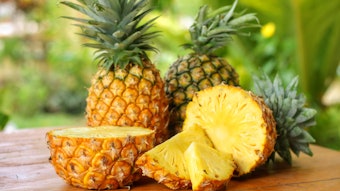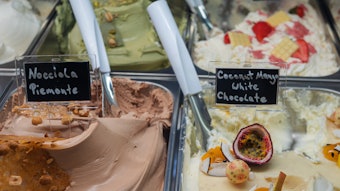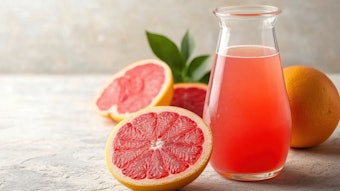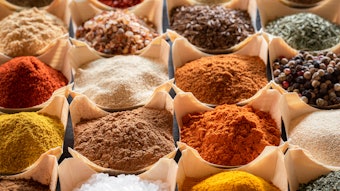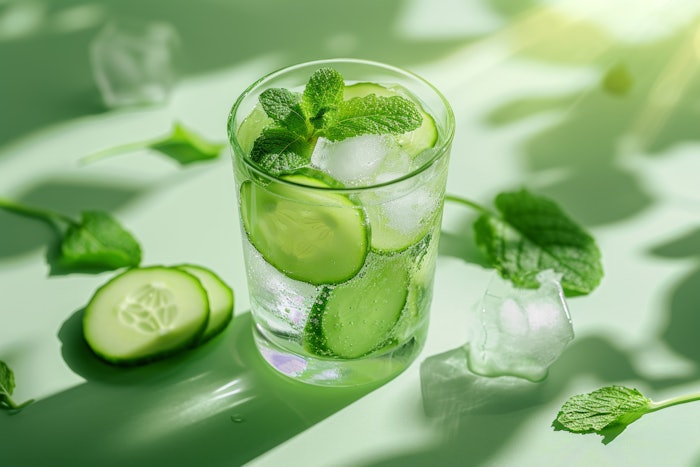
Increasingly focused on being their best selves, consumers are seeking beverages that align with their personal wellness goals, while also providing exciting taste experiences. Uplifting mint has been linked with aspects of well-being by people both past and present. From its herbal roots to daily refreshment on the go, mint has evolved in its uses and associations. By understanding this progression, flavorists and product developers alike can leverage mint to entice those consumers focused on positive nutrition with a wide range of beverages and satisfying taste sensations.
Cultivate Mint’s Humble Roots
Aromatic mint leaves have a storied history as infusions or tisanes, steeped herbal beverages served for enjoyment and perceived wellness attributes. The mint leaf profile is very specific to its varietal: Mentha arvensis (arvensis or cornmint) has bolder menthol characteristics, Mentha piperita (peppermint) is sweeter and creamier, Mentha spicata (spearmint or garden mint) has fresh, green notes, while still other varietals have more earthy flavor profiles. Garden mint provides the distinctive mint flavor commonly found in alcoholic drinks like mojitos, mint juleps and grasshoppers, as well as beverages like mint lemonade and cucumber mint water.
 Mint has also been an important herb in traditional holistic approaches to wellness support.Adobe Stock
Mint has also been an important herb in traditional holistic approaches to wellness support.Adobe Stock
Mint has also been an important herb in traditional holistic approaches to wellness support. Folk remedies have linked mint to soothing digestive issues and helping alleviate headaches. Modern researchers have explored the potential effects of menthol on digestive health, particularly related to abdominal pain, bloating and irritable bowel syndrome (IBS). For instance, peppermint is antispasmodic, so it has the potential to relieve bloating and flatulence and relax the bowel wall. The active compounds concentrated in mint leaves are also believed to help decrease inflammation, improve blood flow and reduce pain sensitivity. Furthermore, aromatherapy associates mint with both calming and stimulating effects. Sipping mint tea may support relaxation while also delivering a caffeine-free spark of energy.
Bottle Up a Good Thing
Although mint remains ingrained in the hot tea market, today’s consumers are also leaning into refreshing beverages, enjoying how mint complements light and bright taste profiles. Mint is an exceptional supporting flavor, adding complexity and optimizing other flavors in a formulation. For instance, the fresh green taste of mint amplifies the seedy notes of raspberry, balances the creamy richness of chocolate and lifts the subtle flavor of pear without overpowering it. New product launches reveal the growing use of herbaceous mint in carbonated soft drinks (CSDs) and sparkling waters, where the fizzy texture and crisp flavor add a lively pop to beverages. Popular flavor combinations include pairing mint with strawberry, apple, watermelon, pineapple, cantaloupe, blueberry and all varieties of citrus, especially lime and lemon.
 Popular flavor combinations include pairing mint with strawberry, apple, watermelon, pineapple, cantaloupe, blueberry and all varieties of citrus, especially lime and lemon.Adobe Stock
Popular flavor combinations include pairing mint with strawberry, apple, watermelon, pineapple, cantaloupe, blueberry and all varieties of citrus, especially lime and lemon.Adobe Stock
In the alcohol arena, 63% of global consumers are interested in mint flavoring in premixed ready-to-drink (RTD) beverages, like a peppermint white Russian for an update of the classic cocktail.1 The sophisticated Southside and variable fruit-based smash cocktails also rely on fresh mint leaves for invigorating flavor. Moreover, 55% of consumers say they are interested in trying a flavored beer or beer mix that contains mint, such as a passionfruit mint shandy or a mango wheat ale. Also, in a recent ADM proprietary study among consumers across North America, the mojito was a top-five cocktail flavor that consumers are interested in seeing in RTD cocktails.
An emerging trend at boutique cocktail bars is mint-washed spirits, similar to the fat-washing technique that adds complexity and dimension to the tasting experience. Mint washing uses alcohol or vermouth to extract oils from the mint leaf, infusing the liquor with uniquely nuanced flavors and aromas. Imagine mint-washed gin with elderflower and a spritz of lemon or a revival of the beloved mojito with mint-washed rum. For the RTD cocktail category, mint flavor extracts may one day mimic these delicate infusions at scale.
Thirst for What’s Next
The newest expression of mint’s evolution is in functional beverages, aligning with consumers’ ongoing interest in personalized and proactive wellness support. Traditional associations between mint and digestion feed into contemporary awareness of the gut microbiome as a key player in overall well-being. For instance, sparkling waters and craft sodas with prebiotic fiber inclusions are gaining market share as “healthy” and delicious options. Think of a juicy and refreshing blend of grapefruit and mint, or a tropical mix of guava, coconut and mint. As a source of probiotics, fermented teas are also linked to gut health, such as a blackberry-mint kombucha.
 Nearly three-quarters of global consumers are checking ingredient lists and nutrition labels (74%) on food and drink products, specifically for “natural” and recognizable ingredients (73%)Adobe Stock
Nearly three-quarters of global consumers are checking ingredient lists and nutrition labels (74%) on food and drink products, specifically for “natural” and recognizable ingredients (73%)Adobe Stock
The active nutrition segment presents another frontier for mint in functional beverages, as consumers seek out solutions for improved focus, productivity, performance and relaxation. Chocolate peppermint protein shakes are a rewarding and nostalgic treat, with mint cutting through creamy dairy notes and brightening the decadent chocolate flavor. The flavor of wild-berry mint works well in energy drinks, with hydrating watermelon mint a great choice for isotonic sports drinks. For adults seeking elevated flavor profiles and a sense of alertness, cooling mint combines beautifully with spicy ginger, floral coriander and zesty lemon. Mint can also bring feelings of calm and ease. Intriguingly, the cooling aspect of menthol can provide these juxtaposing characteristics in better-for-you beverages.
Ultimately, consumers are acting for today to support a better tomorrow. There is a growing movement from health-conscious consumers to support the planet through positive purchasing decisions, and shoppers expect brands to be transparent and accountable. For example, nearly three-quarters of global consumers are checking ingredient lists and nutrition labels (74%) on food and drink products, specifically for “natural” and recognizable ingredients (73%).2 This demonstrates a need for reassurance that care and attention have gone into the formulation of their food and beverage purchases. Consumers want authentic products that they equate to being better for themselves and the environment, and the responsible growing and sourcing of mint is a way beverage brands can address this demand.
Fill Up on Beverage Success
As a “close-to-nature” botanical, mint has the versatility to create many complex flavor pairings and has evolved to serve a variety of beverage formats. Whether it’s infused in hot tea or chilled sparkling water, muddled in classic cocktails, or adding refreshment to energy drinks, mint provides a sprig of the unexpected. Quality mint oils and extracts can help product developers achieve their clean label targets by using botanical ingredients responsibly sourced from nature. Recent scientific advancements have enabled mint varieties that can be grown with less water, fertilizer and energy than traditional mint plants. Brands that can capture authentic mint flavor in beverages that have a smaller environmental impact will have a significant edge with the discerning consumers of today and tomorrow.
References
1. ADM Outside Voice℠
2. FMCG Gurus, Top 10 Trends for 2024
